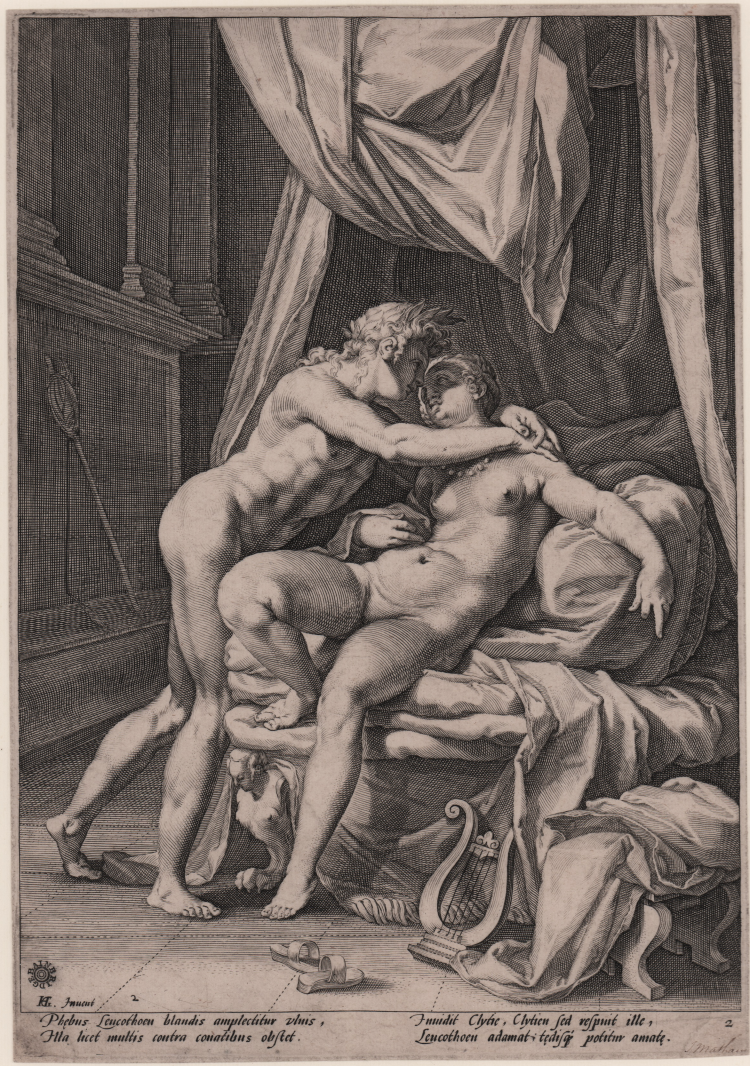




| Reference: | S39065 |
| Author | Jacob MATHAM |
| Year: | 1590 ca. |
| Measures: | - x - mm |



| Reference: | S39065 |
| Author | Jacob MATHAM |
| Year: | 1590 ca. |
| Measures: | - x - mm |
Engraving, c. 1590, lettered and numbered in lower left corner: "HG invent" and "2".
Lettered, below with four lines of verse: "Phebus Leucothoeu blandis... / ... potitur amate." After a drawing by H. Goltzius.
A very good example, printed on contemporary laid paper, trimmed close to platemark, with unidentified watermark, in good condition.
Plate 2 of four, of a series The loves of the gods. It shows Apollo (Phoebus) and Leucothea. Interior of a bedroom with Apollo at left, putting his arms around the neck of Leucothea, both falling back on to a bed, a lyre is propped against the bed in lower right corner, a pair of slippers in central foreground.
According Ovid, Met. IV 190 -255) Venus has her revenge on the Sun-God by making him victim to the pains of love. He dons drag to appear as Leucothoe's mother in order to get close. A jealous Clytie rats her out to her father, who, despite her cry that " He ravished me / Against my will" (81), buries Leucothoe in the earth. The Sun-God cannot revive her, and instead she turns into frankincense.
Collector’s mark of George Bainbridge (Lugt 1921).
|
New Hollstein (Dutch & Flemish) 172.I (Jacob Matham); Hollstein 234; New Hollstein (Dutch & Flemish) 593 (Hendrick Goltzius; Prints after inventions by Goltzius); Bartsch III.169.157.
|
Jacob MATHAM (Haarlem 1571 - 1631)
|
Jacob Adriaenszoon Matham (Haarlem, October 15, 1571 (baptized) - Haarlem, January 20, 1631) was a Dutch engraver and draftsman of the Golden Century.
Father of engravers Jan, Adriaen and Theodor, was a pupil and stepson of Hendrick Goltzius, who married Jacob's mother in 1579, took him as his apprentice. He was active first in Italy from 1593 to 1597, where he stayed mainly in Venice and Rome, and then in his hometown from 1598 to 1631. In 1600 he became a member of the local Guild of San Luca. In 1601 he obtained a printing privilege from King Rudolph II in Prague. He devoted himself mainly to the realization of religious subjects, producing also devotional prints, landscapes and portraits, especially of his contemporaries made on copper. His works show the influence of Hendrick Goltzius, from whose drawings and paintings he made several engravings and whose manner he imitated closely. A very prolific author, he made several engravings both from the works of Italian authors (from his own drawings or those of Goltzius), and from the works of Pieter Paul Rubens from 1611-1615 and Pieter Aertsen. Matham had several pupils including Johannes Everardsz van Bronckhorst, Pieter Soutman, Jan van de Velde II and his son Adriaen.
|
|
New Hollstein (Dutch & Flemish) 172.I (Jacob Matham); Hollstein 234; New Hollstein (Dutch & Flemish) 593 (Hendrick Goltzius; Prints after inventions by Goltzius); Bartsch III.169.157.
|
Jacob MATHAM (Haarlem 1571 - 1631)
|
Jacob Adriaenszoon Matham (Haarlem, October 15, 1571 (baptized) - Haarlem, January 20, 1631) was a Dutch engraver and draftsman of the Golden Century.
Father of engravers Jan, Adriaen and Theodor, was a pupil and stepson of Hendrick Goltzius, who married Jacob's mother in 1579, took him as his apprentice. He was active first in Italy from 1593 to 1597, where he stayed mainly in Venice and Rome, and then in his hometown from 1598 to 1631. In 1600 he became a member of the local Guild of San Luca. In 1601 he obtained a printing privilege from King Rudolph II in Prague. He devoted himself mainly to the realization of religious subjects, producing also devotional prints, landscapes and portraits, especially of his contemporaries made on copper. His works show the influence of Hendrick Goltzius, from whose drawings and paintings he made several engravings and whose manner he imitated closely. A very prolific author, he made several engravings both from the works of Italian authors (from his own drawings or those of Goltzius), and from the works of Pieter Paul Rubens from 1611-1615 and Pieter Aertsen. Matham had several pupils including Johannes Everardsz van Bronckhorst, Pieter Soutman, Jan van de Velde II and his son Adriaen.
|